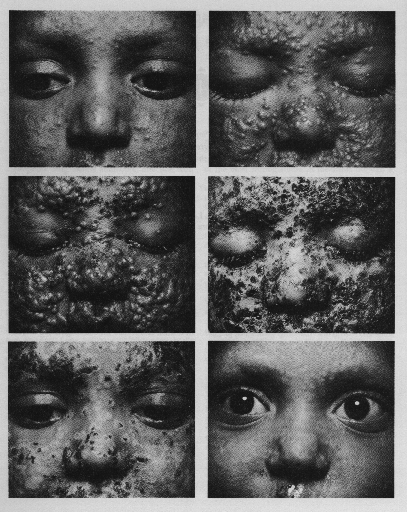SMALLPOX
So, we all know that the world has been freed from smallpox. The only form left of variola virus- the causative agent of smallpox- can be found in five high-security labs in Russia and the United States, although some experts allege that not all variola stocks have been accounted for. Even though the majority of us will never see the clinical manifestations of smallpox, it does not mean that we cannot learn about a virus that severely impacted humanity. Below is a summary of the key features of variola virus.
Epidemiology
Smallpox was recognized and feared for many centuries in all parts of the world. One of the features that contributed to its eradication was that variola virus only infected humans. Smallpox was spread through respiratory transmission of virus found in the oropharyngeal secretions of infected individuals.
Symptomatology and Outcome
Two clinical forms of smallpox existed: variola major and variola minor. Variola minor produced a much less severe toxemia, and it had a case-fatality rate in unvaccinated individuals of about 1%, compared to 10%-30% for variola major.
The onset of smallpox was acute, with fever, malaise, headaches, and backaches. The initial toxemia phase lasted 4-5 days. On about the third or fourth day, the characteristic rash appeared. First, it appeared on the buccal and pharyngeal mucosa, the face, and the forearms. Within a day, it spread to the trunk and lower limbs.
The lesions of the rash began first as macules, which soon became papules, and then developed into pustular vesicles. The lesions usually protruded from the skin and they were firm to touch. About 8 weeks after onset of the rash, the lesions dried up and became crusted by day 14. By the end of the third week, most crusts had fallen off, with the exception of the palms and the soles.

The rare hemorrhagic type smallpox that appeared in immunocompromised individuals was associated with bleeding from the conjunctiva and mucous membranes, very severe toxemia, and early death, usually before the lesions of the skin had developed. Flat-type smallpox, another clinical type of smallpox, was characterized by severe toxemia and delayed appearance of the skin lesions, which were commonly flat and solid. Most cases were fatal. Finally, modified-type smallpox was seen in persons who had been vaccinated, usually many years earlier. In these cases, the skin lesions evolved quickly and they were more variable in size.
Incubation period
The incubation period for both variola major and variola minor was between 10-14 days. During this period, the individual was not infectious.
Pathogenesis and pathology
Infection usually occurred by inhalation of virus found in the oropharyngeal secretions of an infected individual during the first week that the characteristic rash appeared. The initial infection in the oropharnxy or respiratory tract did not produce symptoms nor did it produce a local lesion that could be clinically recognized. Patients were not infectious during the incubation period.
Upon infection, early viral replication took place in the lymphoid organs: the spleen, bone marrow, and lymph nodes. The cell-associated virions, and infected macrophages, became localized in small vessels of the dermis. Infected macrophages would then migrate from these vessels into the epidermis, where they would in turn infect nearby cells of the basal layer. Necrosis and edema followed, with obstruction of the dermis.
The first components of the immune system to become manifest upon mounting an immune response, were cytotoxic T cells. These cells promptly destroyed many infected cells before they produced virions by reacting with antigens in the cell membranes. In cases in which an early cell-mediated immune response occurred, replication of the virus was inhibited and the skin lesions were restricted. However, in immunocompromised individuals, hemorrhagic smallpox usually occurred.
The outcome of infection was either death or recovery with immunity. Variola virus did not persist in the body after recovery. Blindness was a rare complication, usually occurring in cases where there was malnutrition and/or a secondary bacterial infection.
Management of Smallpox
In 1966, the World Health Organization started a program for the worldwide eradication of smallpox. Several features of the virus aided their efforts. Firstly, variola virus was distinctly a human virus with no animal reservoirs. Secondly, case finding was aided by the appearance of the distinctive rash. In addition, the fact that subjects were not infectious during the incubation period allowed for effective containment of infected individuals. Finally, the vaccinia vaccine was very effective in conferring immunity.
Surveillance and control programs were rigorously instituted with strict monitoring of travelers arriving from previously infected areas, which helped keep many countries viral-free. Through intensive case finding and vaccination of direct and indirect contacts, the disease was finally eradicated on December 9,1979.
Although the virus can now only be found in the frozen state in five laboratories, the dreaded possibility remains that undetected foci of disease exist somewhere or that some non-approved laboratories have not destroyed their viral stocks. Because smallpox vaccination is no longer recommended throughout the world, the results could be devastating if reinfection occurred.